With Australia committed to reaching net zero emissions by 2050, innovations that focus on renewable energy sources are becoming increasingly vital.
These two renewable energy programs in mining are examples of the path towards a cleaner, brighter future.
Opening image: Professor Brooks with a machine designed to study the smelting of metals. Image: Create Digital.

Renewables in the mining industry: RUC Shaw first electrical winder. Image: RUC Mining.
Green steel
Swinburne University of Technology has discovered a new way to process metal using renewable energy, potentially stopping millions of tonnes of carbon dioxide from being released into the atmosphere.
Currently, the production of steel accounts for 11 percent of global carbon dioxide emissions, according to a report from the Carbon Brief. This contributes to climate change, as well as damaging the atmosphere.
While iron and steel are typically extracted from iron ore using carbon, a team from Swinburne led by Professor Geoff Brooks, have been studying the effects of using hydrogen for extraction instead.
“If we can’t decarbonise steel, humanity is in big trouble,” Professor Brooks told Create Digital. “Businesses will continue to need a vast amount for the foreseeable future, so it’s impossible to overstate the scale of the challenge.”
Australia remains the largest exporter of iron ore in the world, meaning the need for renewable energy alternatives remains a pressing matter.
Professor Brooks, who was recently named as the new Chair for the Sustainable Mineral Processing and Green Steel Program in partnership with CSIRO, hopes to continue working on the production of green metal using hydrogen over the next four years.
“If you want green energy, you must embrace mining,” he explained. “To meet global renewable energy targets by 2040, we’ll need to mine six times more critical metals than we do currently.”
Brooks believes that focusing attention on the critical metals used in solar energy plants and batteries could be a bright solution. However, work needs to be done before this becomes an affordable solution.
“Using hydrogen instead of carbon to process iron ore is currently about 40 percent more expensive.
“Making it more commercially viable will be complex, but we know it’s scientifically possible.”
Professor Brooks is confident that his team of staff and students is up for the challenge.

Renewables in the mining industry: Energy storage for mine hoists. Image: RUC Mining.
Underground mine hoists
As Professor Brooks looks to revolutionise the processing of critical minerals, RUC Mining and Rockwell Automation are concerned with the collection of said minerals.
Underground mining hoists are the machines used to raise and lower minerals through a mine shaft. They provide an efficient and space-conscious alternative for transporting materials, which would otherwise call for large and expensive machinery. However, while lowering these minerals requires minimal energy, lifting them upwards uses a significant amount of power.
It’s this energy disparity that inspired RUC Mining to consider whether it would be possible to generate energy on the way down, and store it to use as power for the mining hoist on the way back up.
RUC electrical manager, Greg Bell, partnered with Rockwell Automation and Energy Power Systems Australia to design the world’s first regenerative energy storage solution for underground mine winders. Their first installation had a hoist capacity of five metres per second, and operated to a depth of 1,600 metres.
When explaining how the system worked, Bell was enthusiastic about the implications of the program
“Most mine hoists use a brake resistor pack with a cooling fan to deal with the heat generated. But these packs create a single point of failure, and are application-specific, so they need recalculation if a variation in brake power is required,” he said.
“Instead, we proposed for the generating power to be supplied back onto the incoming supply bus, to be absorbed by system loads.”
By reducing the amount of diesel needed to power the mining hoists, RUC was able to achieve significant environmental benefits.
This included, as determined through estimates of the first installation over a 24 month period, a drop in diesel consumption by 1,427 kilolitres, equivalent to around $2 million. It also resulted in a reduction of carbon emissions by 3.85 tonnes, the same as driving 12,700 km in a petrol car, and a 42 percent reduction in greenhouse gas emissions.
“In addition to these strong sustainability benefits, the regenerative energy storage solution also reduces daily operating costs, reduces plant operating hours and maintenance requirements, and provides an additional level of redundancy to the power system that was not available in passive components such as load banks,” said Bell.
“Because power goes straight back to the battery with no heat loss, this type of solution could readily be scaled down to any energy application – even something like elevators. We believe this is the only successful gravity kinetic energy storage system using a hoist in the world, and we are proud to be introducing it here in Australia.”
Enjoyed reading about renewables in the mining industry? For the latest innovations in mining, click here.

